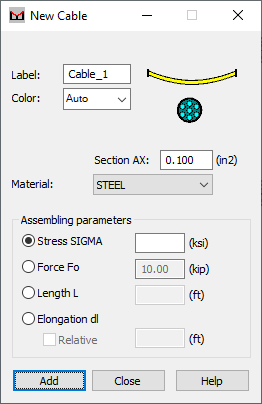Click ![]() in the Cables dialog to display the New Cable dialog, which lets you define a new type of cable.
in the Cables dialog to display the New Cable dialog, which lets you define a new type of cable.

To define a cable, you specify the following parameters:
- Label
- Color
- Cross-section AX
- Material
- One of the following optional assembling cable parameters:
- Stress SIGMA
When selected, it defines the normal stress, calculated with respect to the cable chord, for an assembling case load. Enter the value of the stress in the appropriate field.
- Force F0
When selected, it defines the cable force, which is calculated with respect to the cable chord for an assembling case load. Enter the value for force in the appropriate field.
- Length L
When selected, it defines the unloaded cable length for an assembling case. Enter the value of the length in the appropriate field.
- Elongation dl (or relative elongation)
When selected, the cable elongation (or relative elongation, if Relative is selected) is defined for the assembling case. Enter the value for elongation in the appropriate field.
Elongation is the difference between the unloaded cable length and the distance between the relevant nodes . If elongation is a positive value, the cable length is larger than the distance between the nodes; if it is a negative value, the distance between the nodes is larger than the cable length.
- Enter a value a value for the selected parameter.
- Stress SIGMA